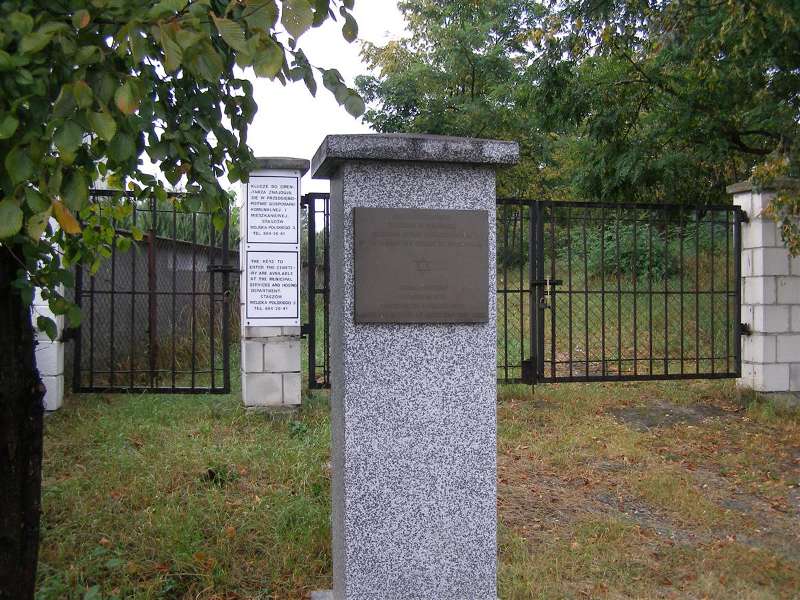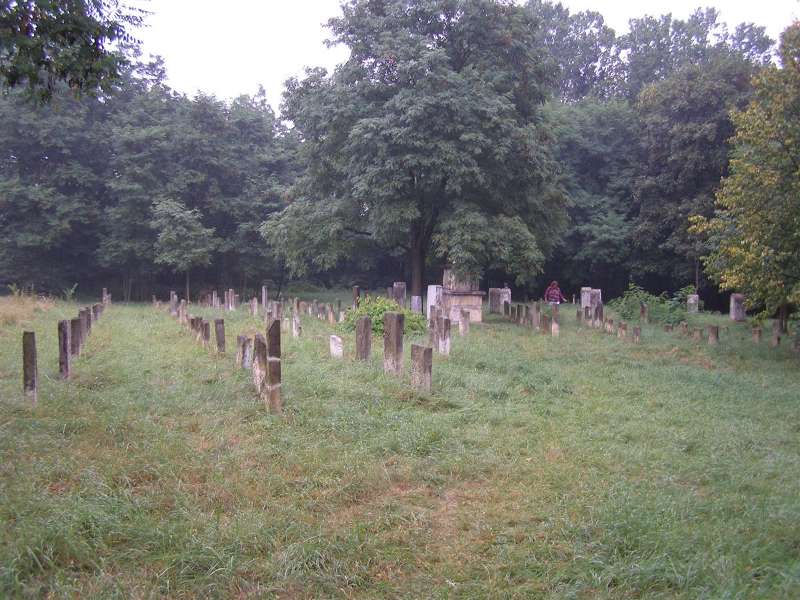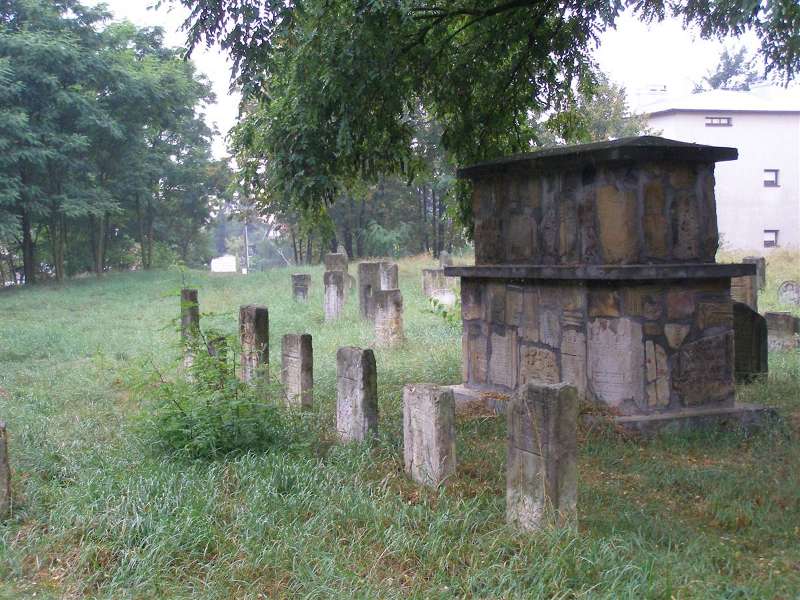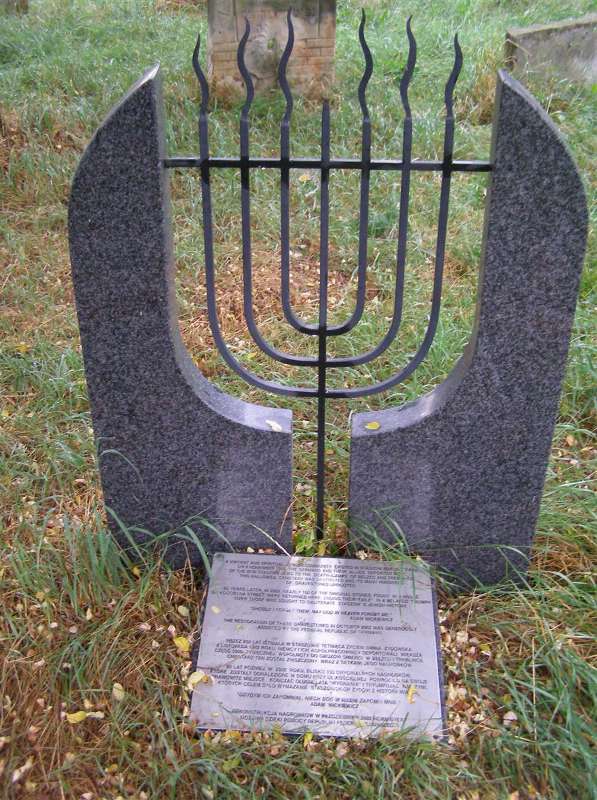 Alternate names: Staszów [Pol], Stashev, סטאשוב [Yid], Stashuv, Сташув [Rus]. 50°33' N, 21°10' E, 29 miles SE of Kielce, 27 miles WSW of Sandomierz (Zuzmir). 1900 Jewish population: 4,903. Yizkor: Sefer Staszow, (Tel Aviv, 1962). Staszów is a town in Świętokrzyskie Voivodship, about 54 km SE of Kielce and the capital of Staszów powiat with a population is 15,642 in 2004. photos. video. photos. Staszow Jewish website. [July 2009]
Alternate names: Staszów [Pol], Stashev, סטאשוב [Yid], Stashuv, Сташув [Rus]. 50°33' N, 21°10' E, 29 miles SE of Kielce, 27 miles WSW of Sandomierz (Zuzmir). 1900 Jewish population: 4,903. Yizkor: Sefer Staszow, (Tel Aviv, 1962). Staszów is a town in Świętokrzyskie Voivodship, about 54 km SE of Kielce and the capital of Staszów powiat with a population is 15,642 in 2004. photos. video. photos. Staszow Jewish website. [July 2009]
A local Polish association - EKOSAN - is taking care of the Jewish cemetery of Staszow. A new padlock on main gate has been installed. According to the agreement between Foundation for The Preservation of Jewish Heritage in Poland and Association EKOSAN, keys to the cemetery gate could be taken from local Museum in Staszow (tel. +48 604 470 448) or by telephone contact on (mobile) numbers: +48 604 980 215 (Darek) and +48 696 696 719 (Andrew). During your stay in Staszow, please call for keys and assistance. A notice is posted at the cemetery gate. Information transmitted by EKOSAN's president, M. Leszek Tybon. Source: Jean-Pierre Stroweis [May 2011]
US Commission Reports No. POCE000230 and 231: In Tarnobrzeg. The US Commission is not finished rechecking this file. [2000]
"Staszow, a shtetl on the road between Kielce and Sandomierz, was home to Jews, tailors and hat makers and goldsmiths from the early 1700s until the Holocaust left it judenrein." Jack Goldfarb is "singlehandedly renovating its 175-year-old Jewish cemetery... In the past 10 years, independent of the Jewish establishment, Goldfarb has spent his own funds — in the high-five figures — on his project. ... And this week, the latest chapter opens — workers in the cemetery are constructing a pair of memorial walls that feature the remnants of 400 Jewish gravestones that were serendipitously uncovered three years ago in a Staszow courtyard. ... Staszow synagogue that survived the German occupation and was torn down in 1952. ...[Before Goldfarb's efforts] the town’s original Jewish cemetery 'was gone,' replaced without a trace by a playground. The newer Jewish cemetery, on a tree-lined hill two-thirds of a mile from the center of Staszow, was an open, empty lot, devoid of the gravestones that had been carted away by the Nazis for use as paving stones on muddy roads and sold to a construction company by municipal authorities after the war when no Jews returned to claim them. ... So he paid to have the grounds spruced up, to have a metal fence built around the area, to have a 10-foot Holocaust memorial constructed, to have some 155 Jewish gravestones he discovered in Staszow homes brought back to the cemetery, to have a marker set up at a Shoah-era mass grave and to have the remains of three putative Staszow Jews who perished during World War II interred. He also engaged a local architect, who designed the concrete-granite Holocaust memorial, which features a Magen David and an inscription in Hebrew, English and Polish. ... Five-thousand Jews, half the population of Staszow, lived there on the eve of the war; 90 percent died in the Holocaust. None have lived there since. About 400 people attended the dedication of the memorial on Nov. 8, 1992, the 50th anniversary of the date of which the Jews in the Staszow ghetto were deported. 'There were only two Jews present' at the ceremony, Goldfarb recalls — himself and a poet from Lodz. ... [146] gravestones eventually were uncovered in the teacher’s courtyard, near the 400 shards from other markers that are being turned into the pair of memorial walls in the cemetery, side by side separated by the Holocaust monument. ...'If people took the initiative,' he said, 'they could all do the same'.” SOURCEL Lipman, Steve. "Saving Cemeteries Here And Abroad: N.Y. man’s crusade to restore Polish shtetl’s burial ground." The Jewish Week. May 18, 2003. [May 2003]
In the fifth photo below, the inscription reads:
A vibrant and spiritual Jewish community existed in Staszow for 250 years.
On 8 November 1942, the Germans and their allies deported most
of the 5000 Staszow Jews to the death camps of Belzec and Treblinka.
This hallowed cemetery was destroyed and its many hundreds
of gravestones uprooted.
60 years later, in 2002, nearly 150 of the original stones, found in a house
on Koscielna Street, were returned here, ending their "exile" in a belated triumph
over those who sought to obliterate Staszow's Jewish history.
"Should I forget them, may God in heaven forget me."
Adam Mickiewicz
The restoration of these gravestones in October 2002 was generously
assisted by the Federal Republic of Germany.
Photos courtesy This email address is being protected from spambots. You need JavaScript enabled to view it.





